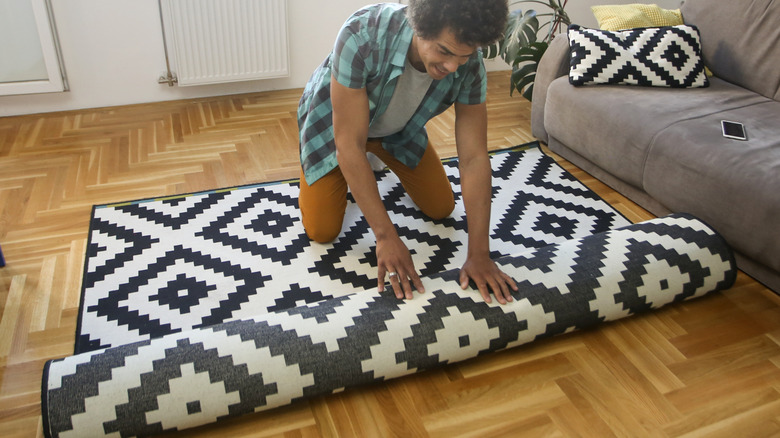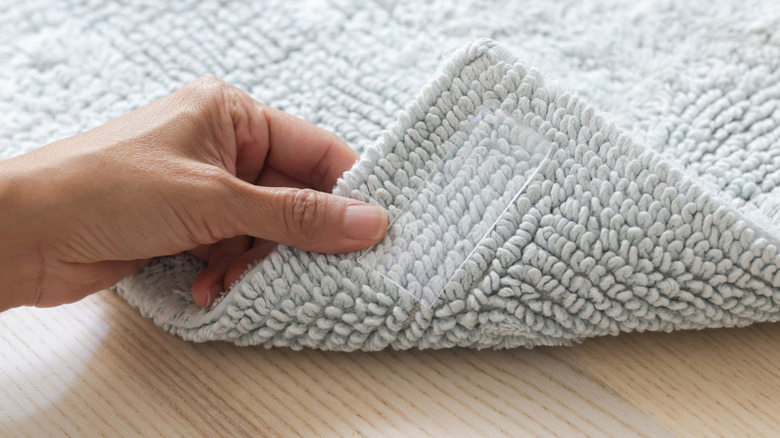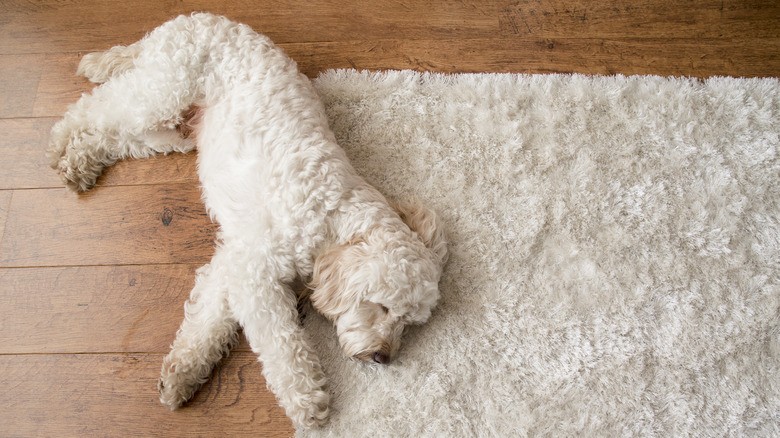Heed One Warning Before Using Rug Tape On Wood Floors
We may receive a commission on purchases made from links.
You've got some beautiful wood floors in your home, and you've taken a lot of things into consideration when choosing an area rug or carpet. You may have heard that rug tape is one option to keep these floor coverings from slipping around. Before you stick the adhesive down, though, you should know not all rug tapes are friendly to wood floors. Rug tape, which adheres the carpet to the floor, comes in different types. It may be made with silicone, rubber, or glue. The advantages of applying rug tape include preventing your rug's edges from curling up and keeping it in its place to avoid a tripping hazard.
Some rug tapes, however, run the risk of damaging your wood floors. They might leave adhesive residue behind when removed, or flake off onto the floor over time. The wrong rug tape can also damage the finish of your wood floors, or even potentially cause other long-term issues, such as warping in hardwood as moisture gets caught between the tape and the wood. The adhesives in rug tapes made with synthetic rubber are more likely to damage your wood floor, whereas silicone tape, such as XFasten Double-Sided Carpet Tape, is generally safer. Whichever tape you use, you'll want to test it on an inconspicuous spot first and apply it to a clean and dry floor.
How to get rug tape off a wood floor
To test your chosen rug tape, apply a small piece onto an out-of-way area, then wait 24 to 48 hours before carefully peeling it up to see if it leaves any residue or discoloration on your floor. Make sure to peel the tape back slowly, at an angle, to avoid stripping your wood finish by harshly ripping it off. If there is remaining residue, or if you or a previous homeowner have left other rug tape on your wood floor, you can get rid of it with a few steps. The longer it's been there, the more difficult it may be to remove. Leaving the tape residue on the floor also gives it more time to attract dirt and debris.
Applying heat to the residue, with a hairdryer or heat gun, can soften it up and make the adhesive easier to remove. Make sure to apply the heat evenly, not concentrating it too long in one spot. When the adhesive residue has softened, you can start to gently scrape it off. It's best to use a plastic scraper or old credit card for this process because harsh scraping can cause scratches on your floor. If adhesive remains, you can use warm water and dish soap, rubbing alcohol, white vinegar, and water, or a commercial adhesive remover such as Goo-Gone to dissolve and remove it. Again, test first in an inconspicuous spot. Let the solution sit for a few minutes, then use a soft, damp cloth to gently wipe the floor clean. Dry thoroughly.
Options beyond rug tape
If you do choose rug tape, follow the previous precautions and make sure to choose a product rated as safe for wood floors. You can also explore other options. Hook-and-loop fastener strips, such as Velcro, work similarly to rug tape by adhering to both your rug and your floor. However, they warrant the same caution about possible damage from the adhesive. Painter's tape might be tempting, but it's designed for temporary applications and can pull the finish from your wood floors. For some silicone non-slippage, you might try applying caulk underneath your rug. The lines of caulk applied on the bottom of your rug will keep it in place, but again, that dried caulk can leave residue on your floor. Fixing your rug down with carpet tacks or nails is another possibility; the potential for tiny holes is the only real risk to your wood floor.
If you don't plan on rearranging any time soon, tucking the edges of your rug under your coffee table or using the weight of your furniture to hold it in place holds minimal risk of damage to your floor. Another safe option is to get a rug pad, in which case you'll want to get one made with felt or natural rubber backing. Natural rubber doesn't have the adhesives of the synthetic form that can harm your floor. Silicone rug gripper strips, rug anchors to hold down the corners, or even furniture grippers are also possible routes for keeping your rug in place.


